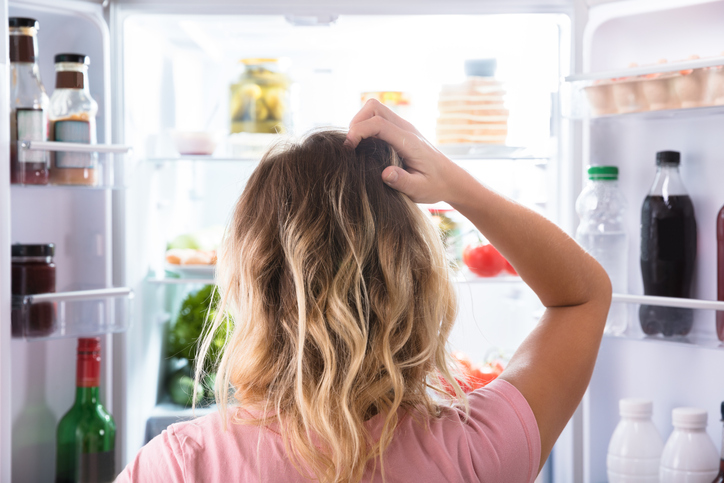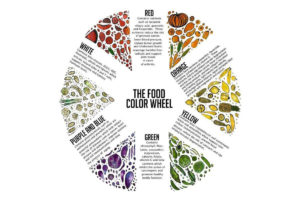
If you had to choose the healthiest food option between a product labeled “natural” and another one labeled “healthy”, which would you pick? They both sound good, right? Well you might have to dig a little deeper because there’s actually no merit to either of the words “natural” or “healthy” when it comes to food labels. This makes it really hard making smart food choices when product marketing can be so confusing and misleading!
Generally speaking, what are the best types of food choices?
- Foods that are high in fiber
- Foods that are minimally processed
- Colorful foods
- Foods that contain live cultures or probiotics (we’ll get more into that later)
- Lean or low-fat protein and dairy
- Foods rich in omega-3s
- And of course, plenty of plants: fruits, veggies, whole grains, nuts, seeds, oils, beans, herbs and spices!
Let’s start with fiber. Why is fiber so good for us?
- It helps with blood sugar control
- It helps keep cholesterol under control
- It helps you stay fuller longer
- It helps with bowel movements
- It helps protect us from colon cancer
- It’s a prebiotic and helps the gut microbiome
Where do we find fiber? Fiber is in vegetables, whole grains, fruit, beans and nuts. How do you know if something is high in fiber? On a food label, when you look at its % daily value of fiber, if the value is greater that 20% then it’s high in fiber and nutrients.
The other way to tell if something has fiber is to just look at the ingredients. The main thing to look for is one specific word, and that word is “whole” as in whole grain. And just so you know, ingredients are listed in order of predominance so the product contains the most of the 1st ingredient, then the 2nd ingredient, and so on down the line. As a side note (but a very important one!) if you do start eating more fiber, make sure to also drink plenty of water because you can get constipated.
Do you know which is better for us…a can of green beans or a frozen bag of green beans? The frozen green beans don’t have any preservatives, so that would be the healthier choice. We want to try to incorporate more whole foods and less processed foods into our diets. What are whole foods? Whole foods are made with real ingredients and are minimally processed (if at all). They are as close to their natural form as possible. Here are some things to think about when it comes to being aware of what a whole food is:
- Can you go to a farm and point at the food you are about to eat?
- How many ingredients are on the food label?
- Can you pronounce all the ingredients on the food label?
Keep in mind it isn’t only the chemicals and preservatives added to foods; added salt, fat and sugar make a difference too!
We’ve talked about the word “natural” and how it has zero definition on a food label, but the other thing we have to be careful with is the word “organic”. People are under the impression that organic food is always healthy, and that isn’t necessarily true. If I bought a really delicious bag of organic cookies, that isn’t necessarily the best food choice, right? Even though something is organic that doesn’t mean it’s not also processed. We want to eat foods that nourish our body and unfortunately a lot of prepackaged foods like chips and cookies don’t do that.
Speaking of additives, there seems to be a lot of confusion still about artificial sweeteners. The latest recommendation is that we should use them in moderation because they do not do the best things for our gut bacteria or microbiome. And just FYI, Stevia is natural but it’s still considered an artificial sweetener.
Probiotics and the microbiome have been trending a lot lately, and for good reason.
The microbiome, in a nutshell, is all the bacteria that live in our intestines and guts. Probiotics are the good bacteria (or live cultures) that help change or repopulate intestinal bacteria to balance the gut microbiome. The reason this is good is because it helps boost immunity and GI health. It can help reduce the risk of heart disease, insulin resistance, inflammation and obesity.
So where can we find probiotic foods? Probiotics are in yogurt, aged cheeses (cheddar, gouda, or mozzarella) kefir, kimchi, sauerkraut, miso, tempeh, kombucha, natto and fresh sour pickles.
Another thing you may have heard a lot about lately is omega-3s. What are omega-3s and why do we need them? Omega-3 fatty acids are very important fats that we must get from our diet. They are know to help with a lot of health issues including:
- Cardiovascular health
- Chronic pain
- Inflammation
- Some types of cancer
- Alzheimer’s disease and dementia
- Age related macular degeneration
What foods are high in omega-3s?
- Flaxseed oil
- Chia seeds
- Hemp seeds
- Walnuts
- Salmon
- Sardines
- Herring
- Mackerel
- Soybean oil
- Canola oil
- Tuna
- Fortified eggs, yogurt and beverages
What about protein and dairy choices?
Saturated fats are found in animal-based foods and can increase cholesterol levels. Foods high in fat also mean high in calories, which may interfere with weight loss goals. If this is a concern for you, consider non-fat or low fat dairy milks, yogurts and cheeses. There are also a number of milk alternatives on the market nowadays including soy, almond, hemp, cashew, rice and coconut, and many options making their way into cheeses and yogurts as well.
Low fat protein rich choices are: skinless chicken/turkey, fish, eggs, tofu, tempeh, beans, peas, some beef/pork cuts (round steaks and loins or select grade) and other lean wild game meats.
Plant-based proteins contain fiber and don’t have saturated fat (unless they’re fried!) so it’s still important to be aware of how they’re prepared.
Finally, I’d like to leave you with a touch of color. Eating a wide variety of different colors of plant-based foods gives your body the best possible nutrition. Each color of fruit and vegetable has a different health benefit. Check out the food color wheel below to see how each one has it’s own health perk.

I know it’s easy to get overwhelmed with making good food choices, but just start small and do what you can. Even a few small changes can have lasting results.
Changing your eating habits is tough, but the more you know about healthy eating the easier it will be to successfully incorporate it into your lifestyle. Knowledge is power!


Leave a Reply